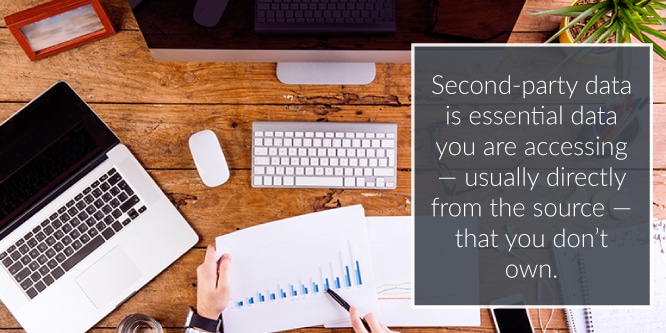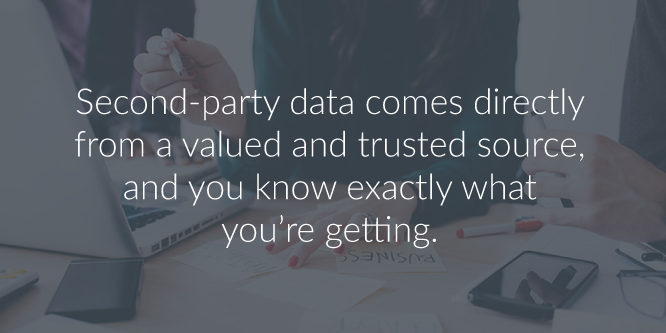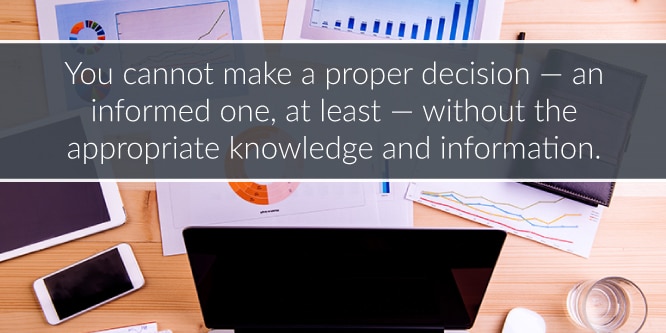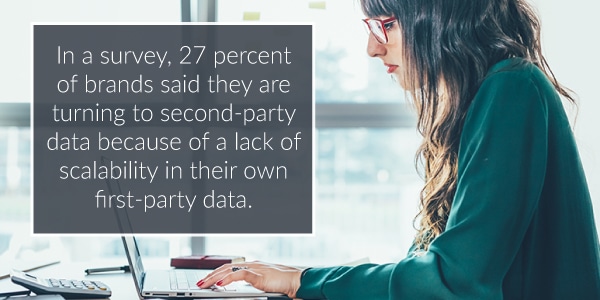How Publishers Can Use Second-Party Data for More Ad Sales
There are three major types of data that brands and businesses can leverage to provide engaging and compelling customer experiences. As you may guess, they are referred to as first-, second- and third-party data.
First-party data is the information you collect through your own systems, including information from your company website, sales and marketing stats from your online storefront, in-store purchase data, CRM data and much more.
Third-party data comes from a variety of sources, which you can guess are rightful “third parties” in the transaction. Third-party data is usually a collection or aggregation of data sources, from anonymous parties, as compiled by a data management platform or system. Unlike first-party or second-party data, it is not transparent. You never quite know what you’re getting.
The final data type is second-party. It is much more reliable for publishers, and offers better performance and higher engagement ratings. It also leads to happier advertisers. The latter contributes to return customers, stronger partner and client relationships and much higher budgets, thanks to an ROI boost.
But how is it so effective, and what can second-party data truly do for publishers? Let’s take a closer look to find out.
What Is Second-Party Data?
Simply put, second-party data is high-quality data you are accessing — directly from the source — that you don’t own. You can think about it as first-party data to someone, just not you.
It has been collected directly by the data owner, and is then shared with another source, whether that be an internal stakeholder or an external partner. There are many benefits of second-party data for all involved.
In acquiring and accessing second-party data, there are no middlemen or aggregators facilitating a transfer. You have access to the data via a direct relationship with the owner of the data source. That allows you to work with the proprietor to decide what’s shared. Unlike third-party data marketplaces where you can seek out available data from anonymous owners, second-party data is still changing hands through a one-on-one relationship.

A five-star hotel and an airline both going after high net-worth travelers may be an example of a good opportunity for a second-party data collaboration. Each partner can choose what to share and who will have access to it. In this case, the two companies do not compete, so the data owner can rest assured they aren’t sharing data with someone who is going to take business away from them. Each partner gets full transparency from the first, knowing full well what data they are acquiring, where it came from, and how it was collected. Of course, this is just a single example, and there are many possibilities and opportunities for businesses regarding second-party data.
What Opportunities Does Second-Party Data Offer Publishers?
You already know what second-party data is, but what can it do for you? As a publisher, do you know how to use second-party data to increase ad sales, marketing strategies and new brand campaigns?

Second-party data has a wide variety of uses. It creates value for your brand and customers, strengthens relationships and trust with key partners and offers proof of value to your advertisers. It also creates new use cases for the segmentation, analysis and connection of first-party data. In other words, you can find new and unique ways to use data. Finally, it offers full control over what data you collect, how much you invest in it and how you choose to use or sell it.
That’s a long list, so let’s break it down.
1. Second-Party Data Creates Value
By nature, data creates value where traditionally there is none. For decades, customers were customers and products were products. Now, it’s about more than that. It’s about the information and insights marketers can gather from customers and products, too, and feeding that back into the marketing cycle to give consumers what they want.
For instance, if publishers know males between the ages of 25 and 35 spend the most time reading the content on your site, that knowledge is valuable in and of itself. You can use it to create more ad space or advertising opportunities your customers will be interested in buying and using. But the information alone also has value. You can sell these insights to partners and other organizations to improve their own business strategies.
Think about it this way. If you could pay to access data that virtually guaranteed the success of an upcoming campaign or decision, would you do so? Most likely, you would, as would many other brands and managers. Therein lies one of the major benefits of second-party data. Marketers know it’s useful, and it’s coming from a trustworthy and reliable source – you.
With second-party data, each partner knows exactly what they’re getting. That makes it much more valuable than the other forms of data. Publishers have full transparency, and each partner can choose what information they need or value most.
2. It Strengthens Relationships and Trust With Key Partners
Accessing and sharing second-party data is, for all intents and purposes, networking. If a marketer or brand is looking to embark upon a data collaboration, they must first research providers, reach out to them and then facilitate the collaboration. Within Lotame’s end-to-end data collaboration platform, Spherical, clients can also choose from brands or media owners already ready to share and collaborate. Reaching out and engaging with a potential parnter is the start of the data collaboration relationship, but once they access, share data, and uncover insights they are looking for, you begin to build trust with your customers.
3. It Will Help Campaigns Perform Better
Because you can better target the correct audience through second-party data, it directly contributes to better-performing campaigns and actions. How? Higher quality data means more accurate data, which means your campaigns are hitting their intended targets. If the right people are seeing your ads, engagement will go up. And this means more repeat customers who are satisfied and happy.

Better performing campaigns mean advertisers end up happier Because their campaigns are successful, they are more likely to offer you repeat business or increased budgets, building a stronger relationship with you in the process. This, of course, leads to a much higher ROI for everyone, including you.
Data From Publishers Is Valuable to Advertisers and Marketers
Marketers and advertisers spend a lot of time making decisions and taking action. They implement new advertising strategies, promotional events and contests, interact with customers and much more. Ultimately, the main goal is to bring in new customers, entice loyal customers to return and to improve the bottom line.
They cannot make a proper, informed decision without the appropriate knowledge and information. That information includes customer data, sales data, trends and market shifts, competing business progress and much more. Publishers can increase ad sales with second-party data simply because it allows you to offer specific and effective audience targeting for marketers, brands and other buyers. Ever visit an e-commerce site and leave, only to see related ads for their products and services everywhere else? This is possible thanks to modern data systems and collective second-party data, but it’s just one example out of many.
Marketers constantly have to be on their toes assessing the lay of the land. Before you can use first-party data, you must parse and organize it. To complicate matters, they never quite know if they’re collecting the right first-party data and information for a particular campaign.
Let’s look at second-party data versus third-party data for publishers and buyers, too. Third-party data comes from a variety of sources and has the same drawback: You don’t know what you’re getting.
Which brings us to second-party data. Advertisers are purchasing or acquiring it directly from a trustworthy source — you, the publisher and data owner — so they know exactly what they’re getting and how to leverage it.
That proprietary data might as well be gold for marketers. If they want to know something about a particular demographic or segment, they can acquire information from a publisher who caters to that specific audience or market. If they want to evaluate the success of past marketing campaigns, they can find a similar business and acquire data that shows its marketing history.
Obviously, these are merely a couple of examples, and the possibilities are endless. Using second-party data for ad sales and marketing strategies is never out of the question. In fact, it’s viable.
The point is that second-party data is proprietary, allowing advertisers and marketers to hone in on exactly what they need. In the fast-moving world of business, the time saved from doing so is not just valuable, it’s crucial. Second-party data can also help marketers tap into new audiences or strategies.
It Creates More Sophisticated Possibilities for Segmentation, Analysis and the Connection of First-Party Data
Remember, second-party data is first-party data — it’s just not originally from a marketers primary source. Therefore, acquiring it can help buyers leverage opportunities more freely. The data exchanging hands is already valuable to the publisher and owner, so that value is nearly cemented for buyers. Second-party data collaboration for publishers is another way to make their own first-party data more valuable and another way to find more customer information for buyers.
More importantly, it opens up doors for marketers and ad buyers that were locked before. Much more sophisticated opportunities for the segmentation, analysis and connection of first-party data are available.
For starters, ad buyers and marketers have more choices and options when it comes to data. They can target new demographics, new audiences and even new regions. They can look for analytical data, historical data, sales data — nearly any kind of data you can imagine. If they need it, it’s right at their fingertips.
Since they also have access to a large selection and quantity of data, they can choose what to acquire and target. This also means they can target specific markets, audiences and customer types.
All the while, they are boosting relationships with publishers — or, if you’re the publisher, with buyers — that can create valuable partnerships in the future, especially when it comes to data sharing and collaboration. If you already know another brand is targeting the same audience as you, and you’ve been working with them regularly, wouldn’t you find them more trustworthy than another random party?
Why does this matter? Because data exchanges hands over time, and in the future, you may need the data you can acquire from loyal partnerships you established in the past. It’s a win-win situation for both parties, really.
The Data Is Always More Reliable Than Third-Party Data
Provided you acquire the second-party data from a viable source, it’s much more valuable and reliable than third-party, and it’s more available that first-party data. It’s another brand’s first-party data, which means it’s recent, and has been accurately maintained.
With first-party data and data of your own, there’s always a certain mystery behind the information you’re getting or collecting. You don’t always know until after everything is organized whether the data will be viable for your current task. With second-party data, you are getting data for the exact market you’re targeting.
While nothing is guaranteed, second-party data at least gives you the assurance that you are, in fact, acquiring information for a real customer, who recently interacted with the data source. That means they’re interested in products and services offered by said data source or a partner.

How Scalable Is Second-Party Data?
How is second-party data more scalable than first-party data? The first reason is that you can choose the amount of data you are selling, acquiring and how much of that you are going to use. It’s also scalable because you can adapt collected and pre-organized data in many ways. You can use it to reach new audiences, compile new marketing strategies and campaigns and even as a base to generate new products.
In a survey, 27 percent of brands said they are turning to second-party data because of a lack of scalability in their own first-party data.
Publishers Have Complete Control
Those acquiring second-party data have complete control over what they are getting and how it’s used. This can be directly attributed to a greater amount of transparency. In comparison, third-party data has no clear provenance because you are getting a large bundle of information, collectively contributed by anonymous sources. After getting the data, analyzing it and putting it into action, you can glean customer insights, but before doing any of this, you have no idea what or how the data you’ve purchased can and will be used.
Second-party data has a defined purpose, source and message. You can pinpoint exactly what you are acquiring, and you can filter out data that is of no use to you. In fact, most second-party data collaboration tools help you find exactly what you’re looking for through platform tools and shortcuts.
Introducing Lotame’s End-to-End Data Collaboration Platform
Second-party data has the potential to be a valuable part tool in a publishers toolbox. It’s trustworthy and accurate, simply because of where it comes from — not to mention, you have full transparency and can plan accordingly before acquiring any data at all. You can target exactly the niche or audiences you want, and you can use just the data you need. All the while, you’re building valuable relationships between your brand and others, and the publishers or data owners.
Contact us to learn more about second-party data and how you can leverage it for your advertising campaigns.